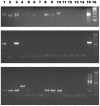DNA extraction columns contaminated with murine sequences
- PMID: 21876752
- PMCID: PMC3158089
- DOI: 10.1371/journal.pone.0023484
DNA extraction columns contaminated with murine sequences
Abstract
Sequences of the novel gammaretrovirus, xenotropic murine leukemia virus-related virus (XMRV) have been described in human prostate cancer tissue, although the amounts of DNA are low. Furthermore, XMRV sequences and polytropic (p) murine leukemia viruses (MLVs) have been reported in patients with chronic fatigue syndrome (CFS). In assessing the prevalence of XMRV in prostate cancer tissue samples we discovered that eluates from naïve DNA purification columns, when subjected to PCR with primers designed to detect genomic mouse DNA contamination, occasionally gave rise to amplification products. Further PCR analysis, using primers to detect XMRV, revealed sequences derived from XMRV and pMLVs from mouse and human DNA and DNA of unspecified origin. Thus, DNA purification columns can present problems when used to detect minute amounts of DNA targets by highly sensitive amplification techniques.
Conflict of interest statement
Figures


References
-
- Lombardi VC, Ruscetti FW, Das Gupta J, Pfost MA, Hagen KS, et al. Detection of an infectious retrovirus, XMRV, in blood cells of patients with chronic fatigue syndrome. Science. 2009;326:585–589. - PubMed
Publication types
MeSH terms
Substances
LinkOut - more resources
Full Text Sources
Other Literature Sources
Research Materials

